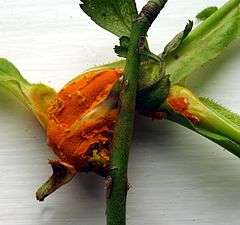Phragmidium
| Phragmidium | |
|---|---|
 | |
| Scientific classification | |
| Kingdom: | Fungi |
| Division: | Basidiomycota |
| Class: | Pucciniomycetes |
| Order: | Pucciniales |
| Family: | Phragmidiaceae |
| Genus: | Phragmidium Link (1815) |
| Type species | |
| Phragmidium mucronatum (Pers.) Schltdl. (1824) | |
| Synonyms[1] | |
|
Ameris Arthur (1906) | |
Phragmidium is a genus of rust fungus that typically infects plant species in the Rosaceae. It is characterised by having stalked teliospores borne on telia each having a row of four or more cells. All species have a caeoma which is a diffuse aecidium lacking a peridium.[2]
There are a number of species of 'Phragmidium most of which are restricted to one or a few host species. Examples include:
- P. acuminatum on Rubus saxatile
- P. bulbosum on Rubus fruticosus and Rubeus caesius
- P. sterilis on Potentilla sterilis
- P. potentillae on Potentilla anglica
- P. rubi-idea on Raspberry
- P. tuberculatum on some Rose cultivars
- P. violaceum on cultivated Blackberry and Loganberry
Possible the most commonly encountered is P. mucronatum found on most species of wild roses including Rosa canina and Rosa arvensis[3]
Pathology
Roses infected with species of Phragmidium will show a characteristic orange mass of spores and distorted growth at specific locations on the bush. The rose may be substantially weakened and lack vigour and may die. Later in the year, small black spots or raised areas will be visible. These are telia containing overwintering teliospores.
Prevention
Rose growers recommend the use of fungicides[4] some of which may have health implications for the gardener.[5] Many cultivated roses are now bred to have resistance to rust diseases. In wild roses, Phragmidium infections are one of a normal range of pests and diseases which are part of the normal ecological pressures affecting all species.
References
| Wikimedia Commons has media related to Phragmidium. |
- ↑ "Phragmidium Link 1815". MycoBank. International Mycological Association. Retrieved 2011-07-08.
- ↑ Fungi. Lilian E Hawker, 1966, Hutchinson University Library
- ↑ Henderson, Douglas M. (2001). A Checklist of Rust Fungi of the British Isles. British Mycological Society. ISBN 0-9527704-4-X.
- ↑ "Royal Horticultural Society Rose rust". Apps.rhs.org.uk. 2011-12-22. Retrieved 2012-02-04.
- ↑ Fungicides: Chemistry, Environmental Impact and Health Effects, , Costa and Bezerra